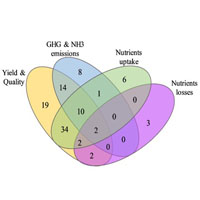Smart fertilizers: What should we mean and where should we go?

Accepted: 19 February 2021
PDF: 1786
Appendix: 188
All claims expressed in this article are solely those of the authors and do not necessarily represent those of their affiliated organizations, or those of the publisher, the editors and the reviewers. Any product that may be evaluated in this article or claim that may be made by its manufacturer is not guaranteed or endorsed by the publisher.
The current agricultural system faces several challenges, the most important being the ability to feed the increasing world population and mitigate climate change. In this context, the improvement of fertilizers’ agronomic efficiency while reducing their cost and environmental impact is one of the biggest tasks. Available literature shows that many efforts have been made to develop innovative fertilizers defined as ‘smart fertilizers’, for which, different interpretations and definitions have been used. This paper aims to define, classify, and describe the new frontier of the so-called smart fertilizers with a particular focus on field-scale studies on herbaceous species. Most of the analysed papers associate the ‘smart’ concept to the controlled and/or slow release of nutrients, using both terms as synonymous. Some others broadened the concept, including the controlled release of nutrients to reduce the environmental impact. Based on our critical analysis of the available literature, we conclude that a fertilizer can be considered ‘smart’ when applied to the soil, it allows control over the rate, timing, and duration of nutrients release. Our new definition is: ‘Smart fertilizer is any single or composed (sub)nanomaterial, multi-component, and/or bioformulation containing one or more nutrients that, through physical, chemical, and/or biological processes, can adapt the timing of nutrient release to the plant nutrient demand, enhancing the agronomic yields and reducing the environmental impact at sustainable costs when compared to conventional fertilizers’.
Highlights
- A smart fertilizer allows to control the rate, timing and duration of nutrients release.
- Nanofertilizers are powder or liquid formulations which involve the synthesis, design and use of materials at the nanoscale level.
- Composite fertilizers are formulations containing nutrients mixed or coated with one or more materials that exploit synergy among materials.
- Bioformulations are fertilizers containing active or dormant microorganisms capable to trigger physiological growth responses in plants.
- Limited information is available for smart fertilizers on herbaceous crops in open field conditions.
How to Cite

This work is licensed under a Creative Commons Attribution-NonCommercial 4.0 International License.
PAGEPress has chosen to apply the Creative Commons Attribution NonCommercial 4.0 International License (CC BY-NC 4.0) to all manuscripts to be published.

 https://doi.org/10.4081/ija.2021.1794
https://doi.org/10.4081/ija.2021.1794



